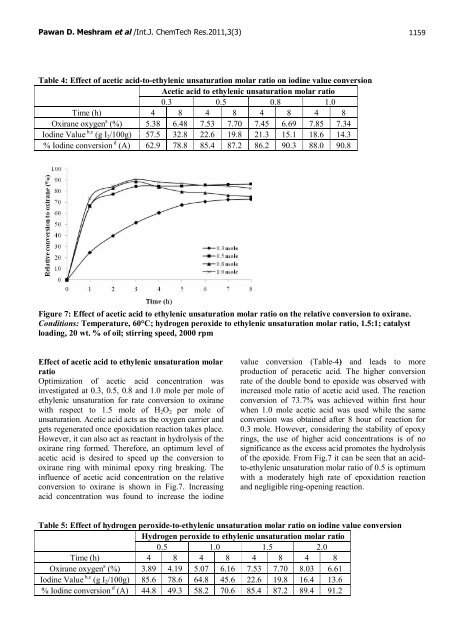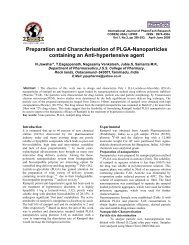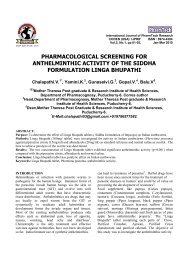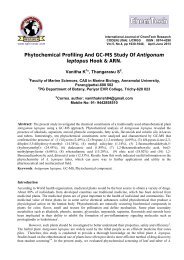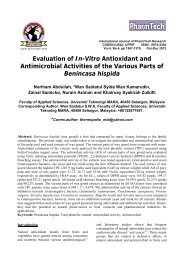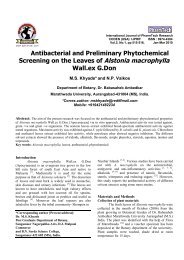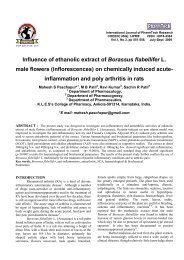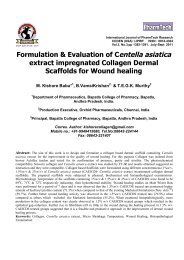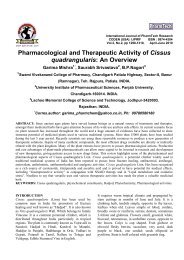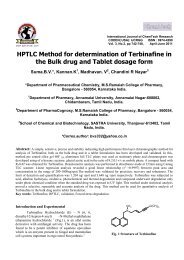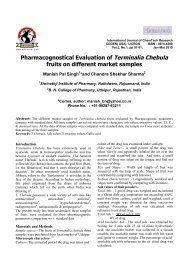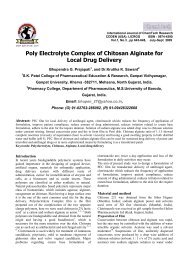epoxidation of wild safflower (carthamus oxyacantha) - Research ...
epoxidation of wild safflower (carthamus oxyacantha) - Research ...
epoxidation of wild safflower (carthamus oxyacantha) - Research ...
Create successful ePaper yourself
Turn your PDF publications into a flip-book with our unique Google optimized e-Paper software.
Pawan D. Meshram et al /Int.J. ChemTech Res.2011,3(3) 1159<br />
Table 4: Effect <strong>of</strong> acetic acid-to-ethylenic unsaturation molar ratio on iodine value conversion<br />
Acetic acid to ethylenic unsaturation molar ratio<br />
0.3 0.5 0.8 1.0<br />
Time (h) 4 8 4 8 4 8 4 8<br />
Oxirane oxygen a (%) 5.38 6.48 7.53 7.70 7.45 6.69 7.85 7.34<br />
Iodine Value b,c (g I2/100g) 57.5 32.8 22.6 19.8 21.3 15.1 18.6 14.3<br />
% Iodine conversion d (A) 62.9 78.8 85.4 87.2 86.2 90.3 88.0 90.8<br />
Figure 7: Effect <strong>of</strong> acetic acid to ethylenic unsaturation molar ratio on the relative conversion to oxirane.<br />
Conditions: Temperature, 60°C; hydrogen peroxide to ethylenic unsaturation molar ratio, 1.5:1; catalyst<br />
loading, 20 wt. % <strong>of</strong> oil; stirring speed, 2000 rpm<br />
Effect <strong>of</strong> acetic acid to ethylenic unsaturation molar<br />
ratio<br />
Optimization <strong>of</strong> acetic acid concentration was<br />
investigated at 0.3, 0.5, 0.8 and 1.0 mole per mole <strong>of</strong><br />
ethylenic unsaturation for rate conversion to oxirane<br />
with respect to 1.5 mole <strong>of</strong> H2O2 per mole <strong>of</strong><br />
unsaturation. Acetic acid acts as the oxygen carrier and<br />
gets regenerated once <strong>epoxidation</strong> reaction takes place.<br />
However, it can also act as reactant in hydrolysis <strong>of</strong> the<br />
oxirane ring formed. Therefore, an optimum level <strong>of</strong><br />
acetic acid is desired to speed up the conversion to<br />
oxirane ring with minimal epoxy ring breaking. The<br />
influence <strong>of</strong> acetic acid concentration on the relative<br />
conversion to oxirane is shown in Fig.7. Increasing<br />
acid concentration was found to increase the iodine<br />
value conversion (Table-4) and leads to more<br />
production <strong>of</strong> peracetic acid. The higher conversion<br />
rate <strong>of</strong> the double bond to epoxide was observed with<br />
increased mole ratio <strong>of</strong> acetic acid used. The reaction<br />
conversion <strong>of</strong> 73.7% was achieved within first hour<br />
when 1.0 mole acetic acid was used while the same<br />
conversion was obtained after 8 hour <strong>of</strong> reaction for<br />
0.3 mole. However, considering the stability <strong>of</strong> epoxy<br />
rings, the use <strong>of</strong> higher acid concentrations is <strong>of</strong> no<br />
significance as the excess acid promotes the hydrolysis<br />
<strong>of</strong> the epoxide. From Fig.7 it can be seen that an acidto-ethylenic<br />
unsaturation molar ratio <strong>of</strong> 0.5 is optimum<br />
with a moderately high rate <strong>of</strong> <strong>epoxidation</strong> reaction<br />
and negligible ring-opening reaction.<br />
Table 5: Effect <strong>of</strong> hydrogen peroxide-to-ethylenic unsaturation molar ratio on iodine value conversion<br />
Hydrogen peroxide to ethylenic unsaturation molar ratio<br />
0.5 1.0 1.5 2.0<br />
Time (h) 4 8 4 8 4 8 4 8<br />
Oxirane oxygen a (%) 3.89 4.19 5.07 6.16 7.53 7.70 8.03 6.61<br />
Iodine Value b,c (g I2/100g) 85.6 78.6 64.8 45.6 22.6 19.8 16.4 13.6<br />
% Iodine conversion d (A) 44.8 49.3 58.2 70.6 85.4 87.2 89.4 91.2


